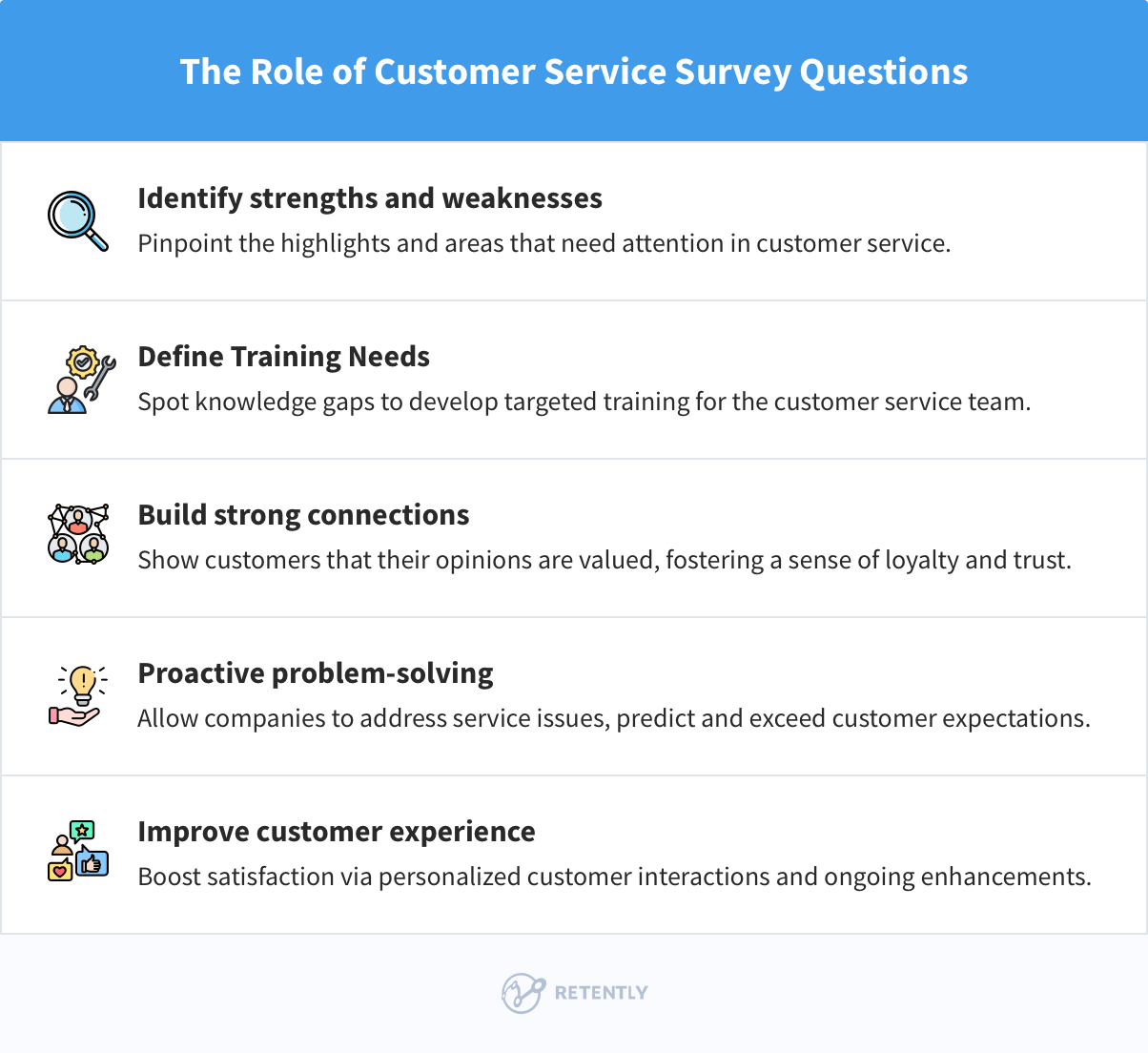Through carefully crafted service survey questions, businesses can glean insights into customer sentiment, measure the impact of their customer service team, and understand the shades of customer satisfaction and loyalty. Whether through a simple “How satisfied were you with our service?” or a more detailed query, each question is a step towards understanding what makes your customers tick.
Harness feedback, discover the key customer service survey questions that can transform your support strategy, and make every customer interaction count. In this article, we’ll hand you the guidance and specific questions necessary to probe customer satisfaction and service quality. Count on actionable insight to elevate your customer interactions.
Key Takeaways
- A customer service survey is a tool designed to collect feedback on customer satisfaction with a company’s service, targeting aspects like response time, problem resolution efficiency, behavior, and overall satisfaction with the service experience.
- Customer service surveys are essential for identifying business strengths and weaknesses, enhancing customer interactions, and monitoring trends to align service with customer needs for growth and retention.
- Surveys come in various types, such as CSAT, NPS, and CES, each providing unique insights into customer satisfaction and loyalty. Well-crafted survey questions are key for relevant and actionable feedback.
- Regular analysis and implementation of changes based on customer service survey results are critical for ongoing improvement in service quality, with templates and specialized survey platforms aiding in efficient survey design and data analysis.
Why Customer Service Survey Questions Matter
In a time when gauging customer needs and expectations is fundamental, the role of customer service surveys comes into focus. These surveys explore the nuances of customer service interactions and might look into the quality of support received, the professionalism of the customer service representative, or the efficiency of the resolution process. Hence, they pose targeted questions and reflect the truthful image of your service from a customer’s perspective.
So, why do they matter? First, they offer customers a voice, an opportunity to express their feelings about their journey with your brand, from the ease of interaction with customer service representatives to the overall satisfaction with the service they received. Second, and most important, customer service surveys offer a wealth of data and endless benefits for businesses. Let’s explore some of the key advantages:
Identifying strengths and weaknesses
The effective use of surveys hinges upon recognizing your customer service’s strengths and weaknesses. By posing well-crafted questions, businesses can capture valuable information about how their customer service is perceived and which areas need improvement. For instance, agent-specific feedback survey questions can help assess the effectiveness of individual customer service agents in handling client concerns.
Understanding customer service agent performance also involves:
- identifying gaps in training or knowledge and providing the necessary support to agents
- monitoring metrics like customer satisfaction levels post-issue resolution
- tracking the time taken to resolve support tickets
By monitoring these metrics, businesses can pinpoint areas for improvement to meet customer expectations better. This process can help companies refine their customer service strategies, ensuring they provide the best possible support to their customers.
Improving customer experience
Each customer’s experience with a business is unique and personal, and surveys can provide invaluable insights into these individual perceptions. By analyzing survey responses, companies can identify trends in the customer service experience, pinpointing areas of strength and those needing adjustment.
Service survey questions effectively uncover customer expectations, allowing businesses to assess whether they are successfully meeting these benchmarks. Moreover, engaging customers directly for their feedback confirms that their input is valued, which can lead to improved loyalty and higher customer retention rates.
Hence, the real power of customer service surveys lies in their ability to improve customer experience via personalized customer interactions and by highlighting specific areas for optimization. Moreover, seeking feedback through customer service surveys underlines the company’s commitment to building a strong, two-way relationship and the dedication to ongoing improvement.
Monitoring trends and customer needs
Customer service surveys also assist businesses in keeping pace with emerging market trends and changing customer requirements. By identifying patterns in customer responses, companies can spot specific areas lacking attention. Moreover, customer pain points can be pinpointed by analyzing recurring themes in survey responses, which helps improve the customer journey.
Not only do customer service surveys gather valuable feedback, but they also serve as potent market research tools. The captured insights are key in crafting strategies to enhance customer retention. Essentially, customer service surveys provide businesses with a roadmap to align their services with customer needs and expectations, thereby driving business growth.

Types of Customer Service Surveys
Having underscored the significance of customer service surveys, let’s explore the variety of customer service survey questions typically employed by businesses. In this context, three main customer satisfaction metrics stand out due to their effectiveness and widespread usage: Customer Satisfaction Score (CSAT), Net Promoter Score (NPS), and Customer Effort Score (CES).
Thus, businesses use three main types of customer service surveys to measure customer satisfaction and loyalty. They all include a numerical satisfaction question and an open-ended question, allowing customers to provide qualitative feedback.
With these, companies can gain valuable insights into customer advocacy, satisfaction levels, and sentiment. Each survey type is designed for a unique purpose and fits different situations. By understanding the purpose of each survey type, brands can maximize the effectiveness of their customer service surveys.
But let’s look into the three for more details:
Customer Satisfaction Score (CSAT)
CSAT surveys measure customer satisfaction with a specific service interaction or overall service experience. To put it into an example, think of “How satisfied are you with the speed of service provided?” vs. “How would you rate your overall satisfaction with the service you received?”.
Customers are usually asked to rate their satisfaction on a scale. By sending the survey immediately after the support ticket is closed, businesses get real-time feedback that reflects the effectiveness of their service team and the immediate impact of the service delivered.
High CSAT scores can help businesses identify best practices and strengths to build upon. On the other hand, consistently low CSAT scores in a particular service area can signal the need for targeted staff training or process reevaluation.
Customer Effort Score (CES)
Customer Effort Score surveys assess the ease with which customers can access and use a business’s service to get their issues resolved or their questions answered – essentially, to get their service needs met. They are specifically designed to pinpoint the friction points in the service delivery process. This survey asks questions like, “How easy was it to interact with our service team?” or “How much effort did you personally have to put forth to resolve your issue?”. A high CES score indicates that customers find the service accessible and straightforward, boosting overall satisfaction and the likelihood of repeat business.
Tracking CES can help businesses to anticipate customer needs and adjust their service strategies proactively to maintain a competitive edge in customer experience.
Net Promoter Score (NPS)
Net Promoter Score surveys measure customer loyalty by assessing the likelihood of users recommending the brand to others on a 0-10 scale. Here is the standard format: “On a scale of 0-10, how likely are you to recommend our service to a friend or colleague? What is the primary reason for your score?”
It’s a broader measure than CES or CSAT, reflecting the overall customer relationship and sentiment towards the company. NPS segments customers into Promoters, Passives, and Detractors based on their likelihood of recommending the service, with the final NPS score ranging from -100 (all Detractors) to 100 (all Promoters). A high NPS suggests customers had positive experiences worth sharing, while a low NPS indicates the need for significant service improvements to foster customer advocacy and loyalty. Industry-specific NPS benchmarks are used to contextualize scores, as averages vary significantly between industries.
What’s more, NPS not only reflects the immediate response to service interactions but also captures the cumulative effect of a customer’s experiences with a company. By tracking NPS over time and analyzing the feedback from different customer segments, brands can leverage the data to identify growth opportunities.
Make sure to check our comprehensive guide on NPS survey questions and response templates for more context.
Essential Customer Service Survey Questions
Alongside the different types of customer service surveys, knowing which questions to pose is equally important. The questions asked in a survey can significantly influence the quality of feedback received. Therefore, it’s essential to carefully craft survey questions to ensure they are relevant, clear, and capable of capturing valuable responses.
Customer service surveys generally include four main categories of questions:
- Agent-specific questions: These help assess the performance and behavior of individual customer service agents.
- Channel-specific questions: These evaluate the effectiveness of different customer service channels.
- Problem-resolution questions: These assess how effectively customer service representatives can resolve customer issues.
- Accessibility-usability questions: These consider the convenience of a company’s service from the customer’s perspective.
These categories of service questions are not mutually exclusive and can often overlap. For example, problem-resolution questions also provide insight into the performance of individual agents or channels. Similarly, agent-specific questions can shed light on the effectiveness of problem-resolution strategies. The key is to design questions that cover all these areas, offering a comprehensive view of the customer service experience.
Agent-specific questions
The performance and behavior of individual customer service agents are evaluated through agent-specific questions. These questions are essential for understanding how each team member contributes to overall customer satisfaction. Satisfaction with the customer support team member is captured by asking customers to reflect on their recent interactions, such as “Based on your recent interaction regarding [incident], how satisfied were you with our customer support team member?”.
Questions that assess communication effectiveness, politeness, agent knowledge, and whether the agent’s actions aligned with a customer’s perception of being helped are also important. For instance, inquiries about:
- whether the service representative seemed well-trained
- whether the agent was able to effectively answer questions and provide solutions
- whether the agent was polite and professional in their interactions
- whether the agent went above and beyond to assist the customer
- whether the agent was quick in delivering the required support
These questions can provide insights into the agent-specific training and development needs within the customer service team.
Examples of agent-specific questions
Rather than offering a lengthy explanation, providing specific examples can more effectively prove the point. So, let’s explore some templates:
- “How satisfied were you with the professionalism of our agent during your interaction?”
- “How would you rate the expertise of our agent regarding our service/product?”
- “How would you rate the quality of assistance you received?”
- “Did our agent resolve your issue or answer your query to your satisfaction?”
- “How likely are you to recommend our services to others based on your interaction with our agent?”
- “How easy was it to get your issue resolved with us today?”
- “How likely are you to use our service again based on your recent experience?”
- “Was the agent prompt in addressing your concerns and providing solutions?”
- “How well did the agent understand your needs and provide relevant assistance?”
- “Did you feel valued as a customer during your interaction with our agent?”
- “What was the most impressive aspect of the service provided by our agent?”
- “Is there anything our agent could have done differently to improve your experience?”
- “How would you rate your satisfaction with our after-service follow-up?”
- “Would you like to acknowledge any exceptional service provided by our agent? Please feel free to share your story.”
Channel-specific questions
Channel-specific questions evaluate customer experiences with various support channels and their preferences. These questions are critical for understanding how effectively different channels meet customer needs and preferences. You can assess customer experience with support channels through questions like “How would you rate your experience with our customer service via (specific channel)?” and “How does our support via (specific channel) compare to other channels you have used?”.
Understanding the preference for support channels can also be determined by questions such as “How likely are you to use (specific channel) again for your customer service needs?” and “What improvements can we make to our (specific channel) to assist you better?”. These questions provide insights into customer preferences and offer valuable feedback on improving the customer experience across different channels.
Examples of channel-specific questions
Again, there is nothing better than specific templates to look into:
- “Was the communication channel you used convenient for your needs?”
- “Did you feel that the communication channel enhanced or hindered your interaction with our agent?”
- “Based on your experience, how likely are you to use the same communication channel again for future inquiries?”
- “How would you compare your experience on this communication channel with other channels you have used in the past?”
- “Were there any technical issues or barriers you encountered while using this communication channel?”
- “Do you have any suggestions for improving customer experience on the communication channel you used?”
Problem-resolution questions
The effectiveness of customer support strategies in resolving customer issues is gauged through problem-resolution questions. For instance, questions such as “Did the customer service representative resolve your issue to your satisfaction?” and “How well did the customer service representative understand your question?” directly assess the resolution’s effectiveness.
The Customer Effort Score is a key metric in this area, helping to measure the effort required by customers to get their issues resolved. This is an essential element of customer satisfaction, as customers who find it easy to resolve their issues with a business are more likely to remain loyal and satisfied.
Examples of problem-resolution questions
- “How satisfied are you with the resolution provided to your issue or query?”
- “Was your issue resolved to your satisfaction during your interaction with our agent?”
- “How would you rate the effectiveness of the solution provided by our agent?”
- “Did the agent resolve your issue in a timely manner?”
- “Was the resolution provided by our agent clear?”
- “How many interactions did it take to resolve your issue?”
- “Did you feel that the agent was committed to resolving your issue?”
- “How confident are you in the resolution provided? Do you believe it will prevent future issues?”
- “How satisfied are you with the overall resolution process, from initial contact to final resolution?”
- “If your issue was not resolved, please share what additional steps you think could have been taken.”
- “Would you like to provide any additional feedback on how we can improve our issue resolution process?”
Accessibility-usability questions
These types of questions in service surveys focus on evaluating the customer’s ease of access and interaction with various service touchpoints. Such questions are designed to assess convenience, approachability, and user-friendliness, providing insights that can help improve the overall customer experience. Consider such questions as: “How would you rate the convenience of our service hours?”, “Did you find it straightforward to contact our customer service team?” or “How would you rate the ease of using our self-service options?”.
Best Practices for Crafting Customer Service Surveys
How a survey is crafted can significantly influence the quality of the received feedback and, therefore, the captured insights. Here are some best practices businesses should follow when crafting customer service surveys.
Primarily, a survey needs to be:
- brief and targeted
- have a visually appealing layout with easy-to-read fonts and simple navigation
- use the customer’s name and reference their specific interaction with your brand to make the request feel more personalized and relevant
- every question in the survey should have a well-defined purpose and have a clear intent
- unnecessary phrasing and questions should be removed to prevent survey abandonment
- a mix of question types, such as multiple-choice, rating scales, and open-ended questions, should be used to ensure a diversity of insights
- a counter of remaining questions during the survey can give customers a sense of progress and encourage survey completion.
Lastly, questions that lead or carry bias should be avoided to prevent influencing the respondent’s answer and distorting the survey results. Examples of leading questions include those that make assumptions, present a leading statement before the question, or combine multiple inquiries into a single question. Biased language – loaded adjectives and adverbs that could influence the respondent’s answer – should also be removed from survey questions.
By following these best practices, businesses can ensure that their customer service surveys are effective, easy to complete, and can surface meaningful and actionable customer feedback.
Using Customer Service Survey Templates
Survey templates can be highly effective in streamlining the survey creation process and ensuring consistency in the data collected. Among the benefits of using them are:
- Templates ensure that you consistently measure the same metrics across different customer interactions, making your data more reliable and easier to compare over time.
- With a template, you can quickly deploy surveys without starting from scratch every time, saving valuable data and ensuring you don’t miss opportunities to gather feedback.
- Templates make benchmarking your results and tracking progress against your historical data easier.
Selecting the right mix of question types and customizing service survey questions to fit the context of the interaction or specific customer segment can improve the relevance of your surveys and the accuracy of the insights you gather. By methodically measuring key aspects like customer satisfaction, effort, and experience, you can gain a well-rounded understanding of your service’s impact on customers.
Here’s what a basic template might include:
- A standard greeting and a brief explanation of the survey’s purpose.
- Questions measuring key metrics (CSAT, CES, NPS).
- Space for open-ended feedback to capture qualitative insights.
- A thank-you message acknowledging the customer’s time and feedback.
A valuable resource for businesses aiming to create, send, and analyze customer service survey questions is specialized survey platforms. These platforms offer a range of features to streamline the survey process, including template customization options, the ability to automate workflows, and in-depth analytics to track improvements or declines in customer experiences over time. Some survey platforms, like Retently, even offer free trial periods, allowing businesses to test the platform’s functionalities before purchasing.
Building a Customer-Centric Culture
Transforming the collected survey insights into actionable strategies is key to enhancing your customer service team’s effectiveness, enriching the knowledge of customer service representatives, and elevating the overall customer service experience. Let’s explore how you can leverage these insights to foster customer retention and loyalty.
Integrating Feedback into Your Support Strategy
The journey towards exceptional customer service doesn’t end with collecting survey responses; it’s where it truly begins. Integrating this feedback into your support strategy is crucial for nurturing a customer-centric culture within your organization.
Use the insights to identify knowledge gaps or areas where your customer service team needs improvement. Develop targeted training programs or workshops to address these areas, focusing on both soft skills (like communication and empathy) and hard skills (such as product knowledge or technical troubleshooting). Training programs based on actual customer feedback ensure your team is equipped to meet and exceed customer expectations.
Integrate customer feedback into your performance metrics for the customer service team. This will ensure that the team’s objectives are directly connected to improving customer satisfaction.
Incorporate customer feedback into regular strategy sessions to ensure customer insights are at the heart of decision-making processes. Establish a feedback loop where customer service representatives are regularly informed about the common complaints highlighted in surveys. Tailor insights from survey feedback to specific roles within the customer service team. This awareness can help them anticipate customer needs and improve their problem-solving approaches.
Empower customer service representatives by giving them the authority to make decisions that can immediately impact customer satisfaction. When employees know they can act directly on feedback, they’re more likely to take the initiative and go the extra mile to resolve customer issues effectively.
Ensuring Ongoing Improvement
Regular customer service surveys are a tool that enables an ongoing cycle of improvement. Promote continuous learning and foster an environment where employees always want to enhance their skills and service delivery.
Leverage insights to tailor interactions with customers. Personalization can make customers feel valued and understood, boosting their satisfaction and loyalty.
Establish benchmarks for customer satisfaction metrics (CSAT, NPS, CES) and use them to measure progress over time. This will set realistic goals and help track the effectiveness of changes made based on customer feedback.
Each round of surveys provides a snapshot of customer sentiment, which, when analyzed over time, reveals trends and patterns. Anticipate customer needs and issues by analyzing these trends and patterns in the survey data. Use survey insights to identify and streamline inefficient processes hindering customer satisfaction. Simplifying these processes can boost the customer experience and reduce customers’ efforts to resolve their issues.
Closing the Customer Feedback Loop
Closing the feedback loop with customers is a critical, yet often overlooked, step in the survey process. It involves informing customers about the feedback received and what actions are being taken as a result. This validates the effort customers put into sharing their opinions and shows your commitment to improving based on their suggestions.
Encourage a culture where customer insights are valued and explored. Share updates with customers through email newsletters, social media, or your website about how their feedback shapes your service. For customers who provided feedback on specific issues, consider sending a follow-up survey to ask about their recent experiences and whether they’ve noticed the improvements.
Expressing gratitude to customers who took the time to provide feedback reinforces a positive relationship. Offering rewards, such as discounts or coupons, can also encourage future survey participation.
Quick Wins
Translating survey results into actionable insights involves moving from data to decision-making. Here are just a few pointers on that:
- Focus on changes that have the potential to significantly improve customer satisfaction and loyalty. Use customer feedback to identify “quick wins” as well as longer-term strategic initiatives.
- For each identified area of improvement, outline specific steps to address the issue. Assign responsibility to team members or departments, set deadlines, and determine how success will be measured.
- Not all changes will have the desired effect. Adopt a test-and-learn approach, where you implement changes on a small scale, measure the impact, and adjust based on results.
Examples of Implemented Customer Service Surveys
Let’s see how renowned companies leverage customer service surveys to enhance their customer experiences. Companies like Skype, Amazon, and Starbucks use customer service surveys to evaluate and improve their customer service.
Skype, for example, either displays the survey at the bottom of their page or offers a direct link to the survey on their official support website so that everyone willing to leave feedback about their self-service options or overall customer service can do so in no time.

Starbucks uses a survey system called “connection scores” to gauge customer service experiences, based on email surveys to reward program members that include questions about store cleanliness, drink quality, and customer engagement efforts. Some employees feel that the survey system, which pushes for creating a customer connection, is distanced from their work reality, particularly with the fast-paced demands of drive-through service.
Only perfect scores (7) positively impact Starbucks’ connection score, putting pressure on staff to ensure customers provide the highest ratings possible. Though Starbucks maintains that connection scores are part of a broader performance assessment and not tied to staffing decisions or as punitive measures, they can affect workplace dynamics.
McDonald’s features label survey prompts on receipts and offers coupons to the ones taking the survey. These examples show how customer service surveys are leveraged to identify customer satisfaction, preferences, and areas for service improvement.
Conclusion
Customer service survey questions are invaluable for businesses looking to understand their customers and improve their services. They provide insights into customer needs and help companies identify their strengths and weaknesses, monitor trends, and enhance customer experiences.
Businesses can meet customer expectations and deliver high-quality customer service by crafting effective surveys, analyzing results, and taking action based on feedback. The insights you gather through customer service surveys are only as powerful as the actions you take in response.
So, let your customers guide your decisions. Sign up for a free trial and take the first step toward great customer service with Retently. By asking targeted questions, you can gather valuable insights to inform your customer service strategies. Your customers have valuable insights to share – are you ready to listen?

















 Christina Sol
Christina Sol 



 Greg Raileanu
Greg Raileanu 


